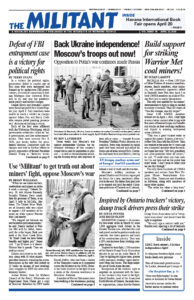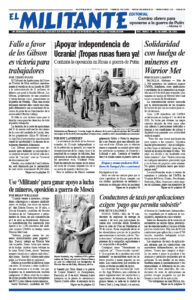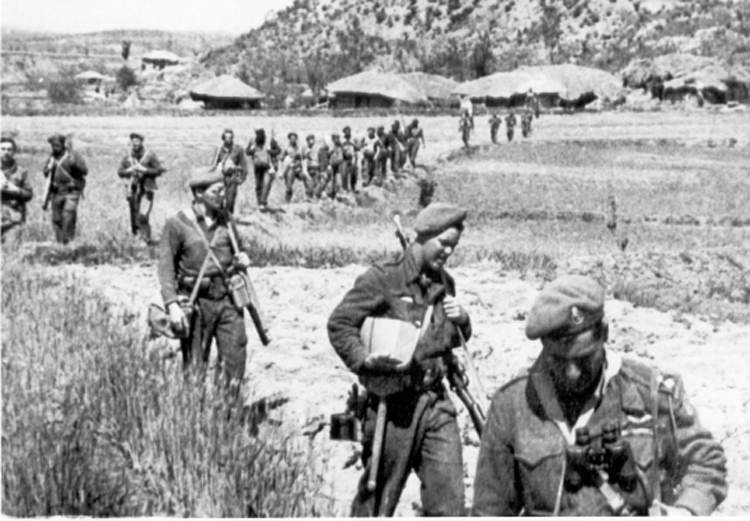MONTREAL — The Canadian government of Prime Minister Justin Trudeau is responding to Moscow’s invasion of Ukraine by beefing up its military forces. The rulers demand working people “sacrifice” for the war as they step up attacks on wages, conditions and rights at home.
Trudeau joined NATO and other meetings with governments officials, held in Europe in late March. They announced a boost to troop deployments from the Washington-led military alliance across Eastern Europe and imposed harsher sanctions against Russia, measures that hit workers and farmers there the hardest.
Canadian Procurement Minister Filomena Tassi announced March 28 that the government is locking down the purchase of Lockheed Martin F-35 fighter jets to replace its aging fleet. Defense Minister Anita Anand pointed to Moscow’s war as the reason.
The government also announced an 8 billion Canadian dollar increase ($6.3 billion) in military spending for the next five years in its April 7 budget, including for aircraft and other armaments. This includes upgrading the rulers’ Arctic defense system and putting more resources into the North American Aerospace Defense Command, an arrangement placing the Canadian air force under joint command with Washington.
The Canadian government has 1,300 troops as part of NATO forces in Central and Eastern Europe, Ottawa’s largest current international deployment.
“The Communist League champions the fight of Ukrainian people to overcome the invasion of their country by Moscow,” said Philippe Tessier, Communist League candidate in the Quebec National Assembly by-election in the Marie-Victorin district in Longueuil, south of here. “While Ottawa and Washington cry crocodile tears over Ukraine, their aim is to strengthen their ability to defend their own predatory interests. Not one cent and not one person for Canadian imperialist intervention anywhere should be the watchword of workers and our allies.”
Canada’s rulers join U.S. wars
The rulers of Canada, a weaker imperialist power, seek to advance their own national interests by linking their foreign policy to Washington’s. In 1949 they made Canada a founding member of NATO, set up under the domination of U.S. imperialism as it emerged as top dog out of World War II. Since then NATO, like the United Nations, has always served as a tool to crush rebellions by workers and farmers, and police the world in the interest of U.S. imperialism.
The Canadian government sent nearly 30,000 military personnel to fight in the U.S. rulers’ 1950-53 ground war and carpet bombing against the people of Korea. Canadian forces joined the U.S.-led wars against Iraq in 1990-91, and Afghanistan in 2001-2014.
In Yugoslavia in 1999, the U.S. rulers imposed a no-fly zone in a war that resulted in the breakup of that country and advanced Washington’s position as the dominant power in Europe. Canadian CF-18s flew 678 sorties in that campaign — 10% of NATO’s flights in a deadly bombardment that destroyed airfields, refineries and manufacturing plants.
While in Europe, Trudeau issued a joint statement March 23 with European Union President Ursula von der Leyen. It pledged “to defend our shared values,” and pointed to a food crisis they said is “caused by President Putin’s war.”
The Canadian government has used the Ukrainian war to justify backing bosses’ assaults on workers’ struggles. In March it claimed a strike by rail workers at Canadian Pacific would exacerbate grain shortages caused by Moscow’s invasion of Ukraine — a blatant attempt to foster opposition among farmers to rail workers’ fight over pensions, schedules and safety.
“In times of war, working-class struggle doesn’t disappear,” Tessier said. “The response of the communist movement is to deepen our participation in union battles.” Tessier, a rail worker at Canadian National and a member of the Teamsters union, pointed to the strike of aircraft workers at Rolls-Royce in Montreal against the bosses’ attacks on pensions and wages. Out of such struggles workers “increase their self-confidence, fighting spirit and class consciousness.”


